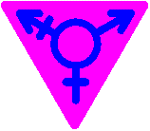
Transgender has become an umbrella term to mean all those who transgress gender norms. Since these norms vary from society to society, the people who cross the line aren't always the same, either.
When we are born, the doctor pronounces us a boy or a girl, and from that moment, gender-based expectations are set. Boys must be rugged and athletic. Girls must be soft and pretty. But real people won't always fit this mold, and people have been working since the first Women's Suffrage conference in Seneca Park to break down the barriers.
There has been much progress in women's rights, but we have yet to achieve full equality. Feminists are striving for equal rights for women. The gay rights movement has come much more recently, and in many environments, people cannot be discriminated against based on who they love.
The remaining groups who suffer gender discrimination are primarily transsexuals, crossdressers, intersexuals, and visibly "gay" men and women. These groups are usually collectively called "transgender" because they don't meet society's expectations for people born with their anatomy.
Policies and laws that prohibit discrimination based on sex, or based on sexual orientation, do not protect those whose gender expression is different. To treat everyone fairly, an explicit policy is needed to ensure that transgender people can work safely and productively, without harassment, discrimination, or the need to stay in the closet.
Remaining closeted is an option for many people. It's not a good option - it takes energy to hide a large part of who you are. But, for people who are afraid for their jobs, it may be the only option. An employee who can bring their whole self to work will be a happier worker, a more productive worker. Straight workers are permitted to talk about their personal lives, to choose their hairstyles and clothing (within workplace boundaries) and to be themselves. GLBT workers long for those same basic human rights.
Transgender people can be measured on the Benjamin Scale, which measures "how transgender are you?" from 0 (not at all transgender) to 6 (desires sex reassignment surgery.) The frequency on the Benjamin scale seems to be shaped like a pyramid, with those measuring 6 at the tip of the iceberg.
Some estimates suggest that 25% of people born male are at least a 1 (has crossdressed for Halloween) on the Benjamin scale. An estimated of 1% to 4% of males are 2 or higher and feel the need to stay "in the closet." By contrast, 100% of females wear male clothing, but American society has accepted the right of women to wear pants (thanks to 150 years of feminist advocacy.)
Crossdressers (2 or 3) will rarely come out in the workplace. Those who feel strongly enough about their gender to affect their job are likely to identify as transsexuals (4 to 6.) In fact, given today's repressive culture, you are most likely to hear from a 6, who cannot survive without changing gender.
Estimates of the number of surgery-bound transsexuals also varies. The DSM-IV estimates that 1 in 30,000 males and 1 in 100,000 females is a Benjamin 6. Lynn Conway estimates that as many as 1 in 1,000 males have already had the surgery. The number of females desiring female-to-male (FTM) surgery is estimated to be from 25% to 100% of the male-to-female (MTF) rate.
In your company, you can make an estimate.
Divide your number of employees by 20,000.
In the author's experience, this number will be close to the
number of Benjamin 6 transsexuals who may have issues for you to deal with.
Add 20% to this number to include the 4's and 5's that may become
known to you in the workplace.
This page Copyright (c) 2001 by Transgender at Work.
All rights reserved.